ELP1202: Methods vs. Post-Methods in Language Teaching in Sri Lanka
VerifiedAdded on 2023/06/09
|8
|1973
|262
Essay
AI Summary
This essay provides a comparative analysis of traditional 'methods' and contemporary 'post-method' approaches in English language teaching, examining their respective advantages and disadvantages. It delves into the theoretical underpinnings of each approach, highlighting the systematic nature of methods versus the contextual adaptability of post-methods. The discussion extends to the practical implications of both approaches, particularly in the context of English language teaching in Sri Lanka, considering factors such as teacher training, curriculum design, and the promotion of social cohesion. The essay concludes by advocating for a perspective that empowers teachers to construct their own teaching methodologies, tailored to their specific classroom environments and student needs, while also acknowledging the limitations and criticisms associated with both methods and post-methods. Desklib offers this essay and many other resources for students.
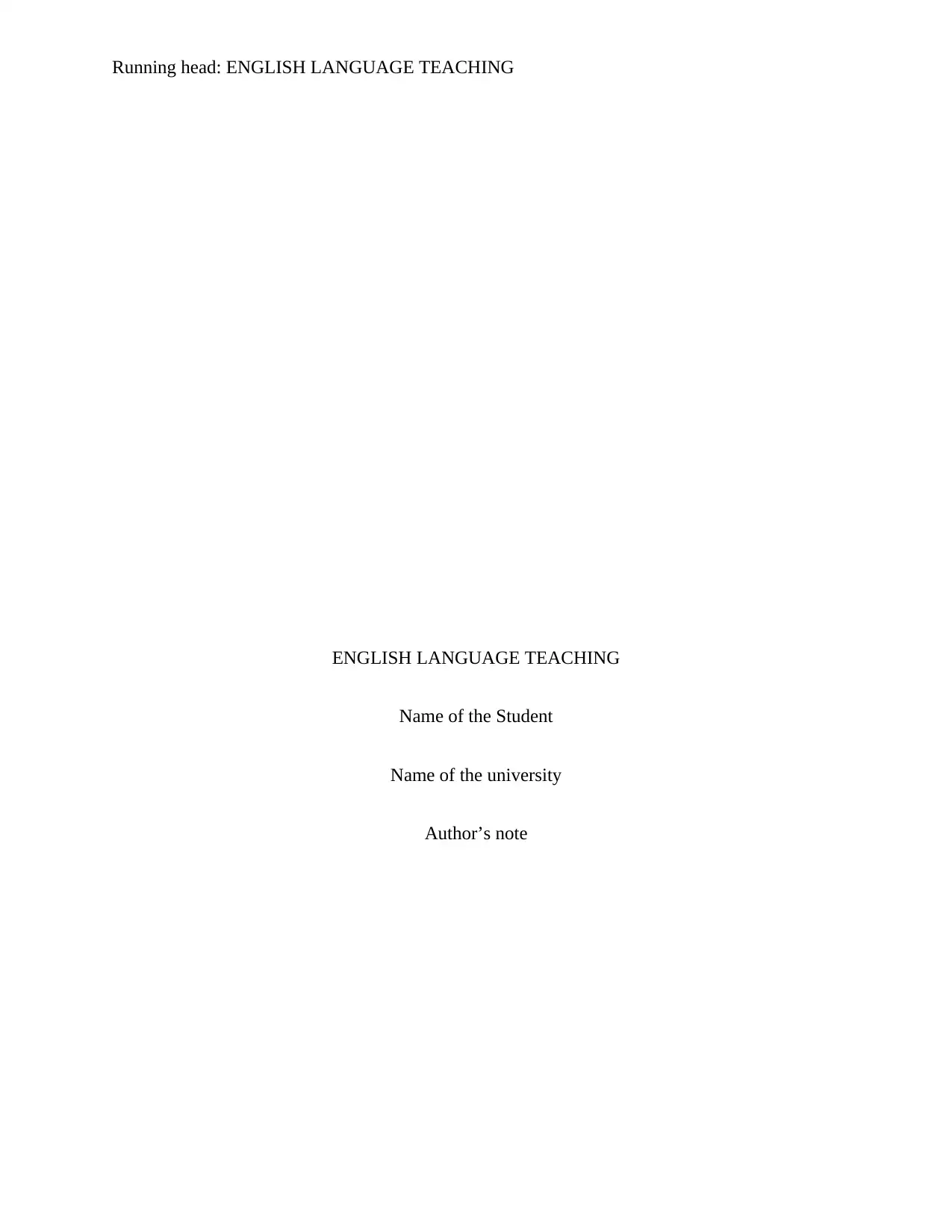
Running head: ENGLISH LANGUAGE TEACHING
ENGLISH LANGUAGE TEACHING
Name of the Student
Name of the university
Author’s note
ENGLISH LANGUAGE TEACHING
Name of the Student
Name of the university
Author’s note
Paraphrase This Document
Need a fresh take? Get an instant paraphrase of this document with our AI Paraphraser
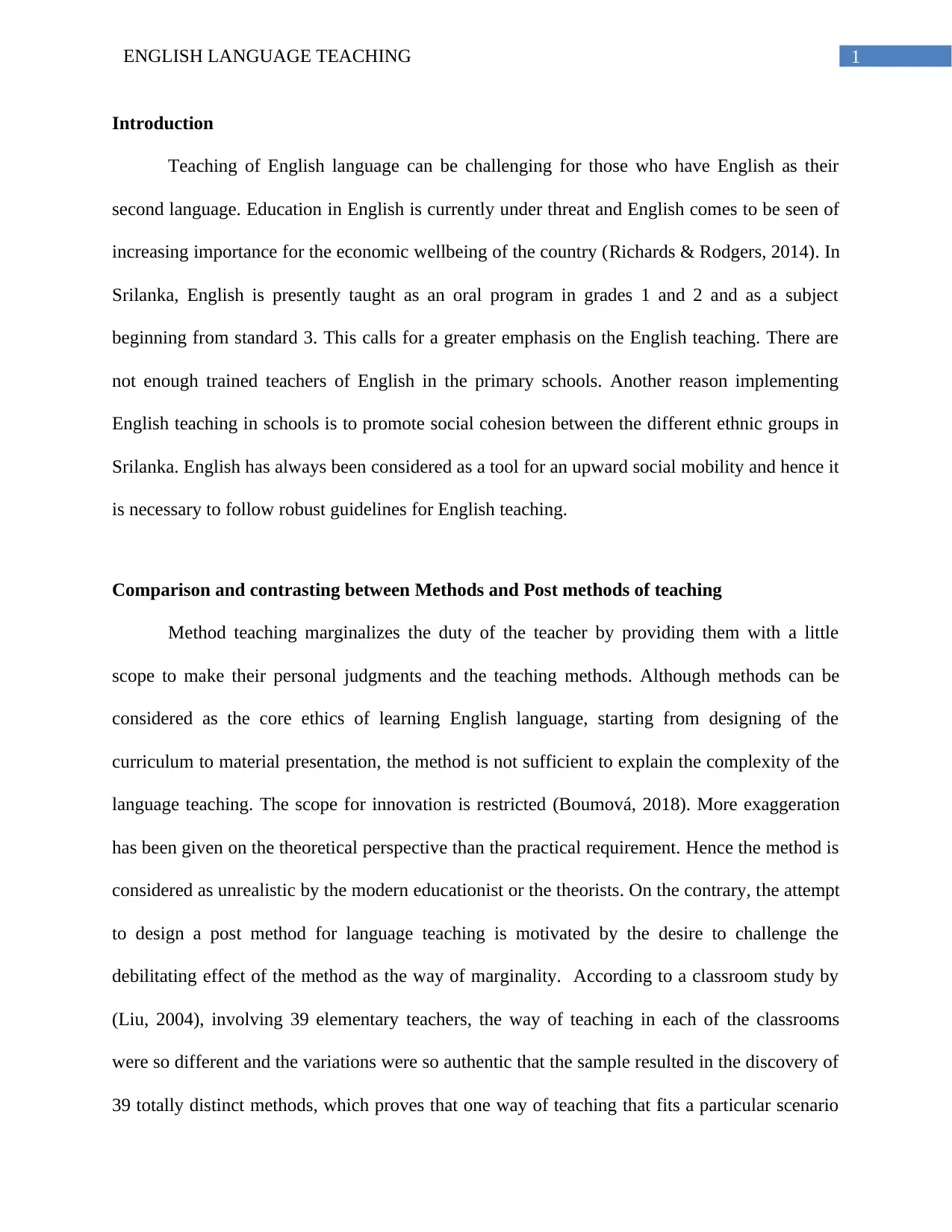
1ENGLISH LANGUAGE TEACHING
Introduction
Teaching of English language can be challenging for those who have English as their
second language. Education in English is currently under threat and English comes to be seen of
increasing importance for the economic wellbeing of the country (Richards & Rodgers, 2014). In
Srilanka, English is presently taught as an oral program in grades 1 and 2 and as a subject
beginning from standard 3. This calls for a greater emphasis on the English teaching. There are
not enough trained teachers of English in the primary schools. Another reason implementing
English teaching in schools is to promote social cohesion between the different ethnic groups in
Srilanka. English has always been considered as a tool for an upward social mobility and hence it
is necessary to follow robust guidelines for English teaching.
Comparison and contrasting between Methods and Post methods of teaching
Method teaching marginalizes the duty of the teacher by providing them with a little
scope to make their personal judgments and the teaching methods. Although methods can be
considered as the core ethics of learning English language, starting from designing of the
curriculum to material presentation, the method is not sufficient to explain the complexity of the
language teaching. The scope for innovation is restricted (Boumová, 2018). More exaggeration
has been given on the theoretical perspective than the practical requirement. Hence the method is
considered as unrealistic by the modern educationist or the theorists. On the contrary, the attempt
to design a post method for language teaching is motivated by the desire to challenge the
debilitating effect of the method as the way of marginality. According to a classroom study by
(Liu, 2004), involving 39 elementary teachers, the way of teaching in each of the classrooms
were so different and the variations were so authentic that the sample resulted in the discovery of
39 totally distinct methods, which proves that one way of teaching that fits a particular scenario
Introduction
Teaching of English language can be challenging for those who have English as their
second language. Education in English is currently under threat and English comes to be seen of
increasing importance for the economic wellbeing of the country (Richards & Rodgers, 2014). In
Srilanka, English is presently taught as an oral program in grades 1 and 2 and as a subject
beginning from standard 3. This calls for a greater emphasis on the English teaching. There are
not enough trained teachers of English in the primary schools. Another reason implementing
English teaching in schools is to promote social cohesion between the different ethnic groups in
Srilanka. English has always been considered as a tool for an upward social mobility and hence it
is necessary to follow robust guidelines for English teaching.
Comparison and contrasting between Methods and Post methods of teaching
Method teaching marginalizes the duty of the teacher by providing them with a little
scope to make their personal judgments and the teaching methods. Although methods can be
considered as the core ethics of learning English language, starting from designing of the
curriculum to material presentation, the method is not sufficient to explain the complexity of the
language teaching. The scope for innovation is restricted (Boumová, 2018). More exaggeration
has been given on the theoretical perspective than the practical requirement. Hence the method is
considered as unrealistic by the modern educationist or the theorists. On the contrary, the attempt
to design a post method for language teaching is motivated by the desire to challenge the
debilitating effect of the method as the way of marginality. According to a classroom study by
(Liu, 2004), involving 39 elementary teachers, the way of teaching in each of the classrooms
were so different and the variations were so authentic that the sample resulted in the discovery of
39 totally distinct methods, which proves that one way of teaching that fits a particular scenario
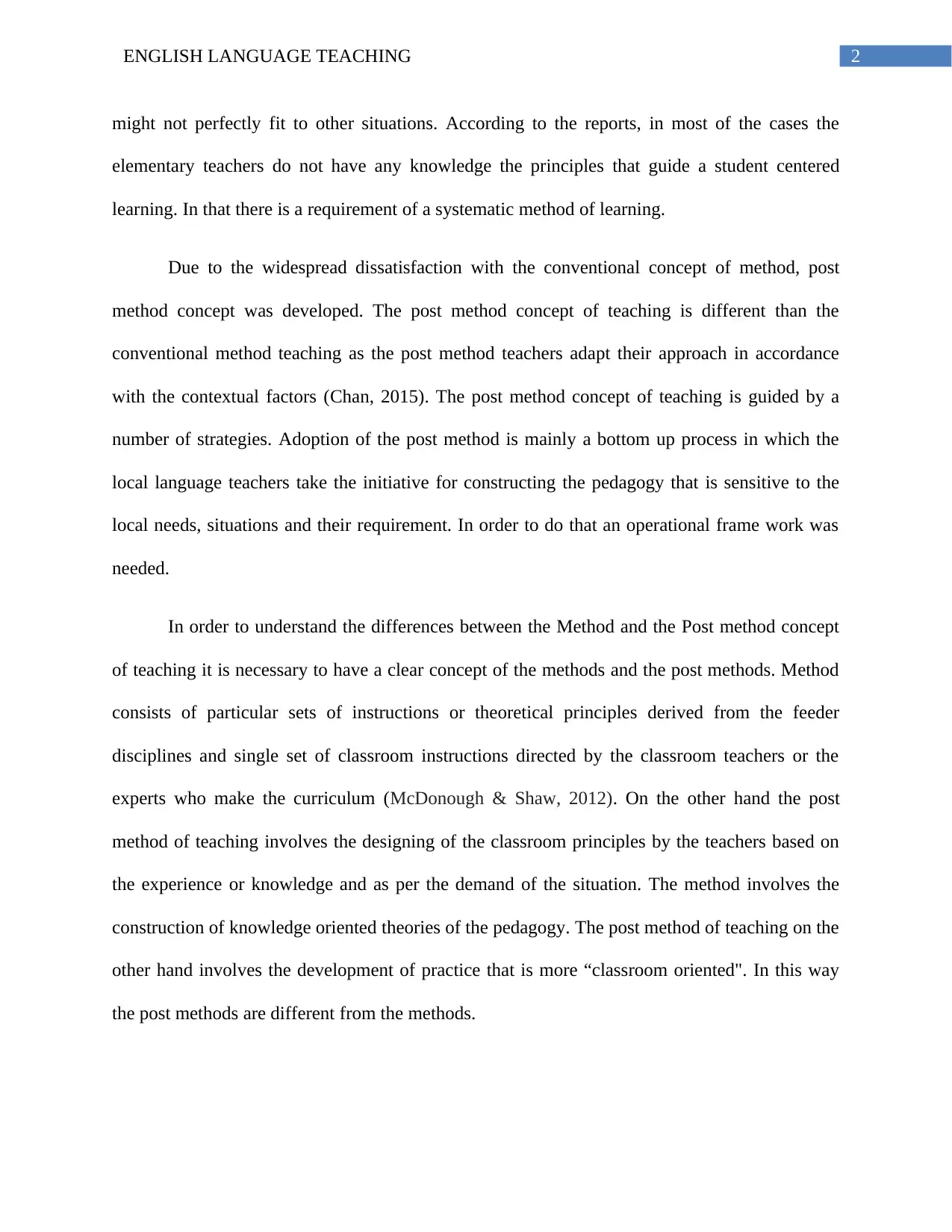
2ENGLISH LANGUAGE TEACHING
might not perfectly fit to other situations. According to the reports, in most of the cases the
elementary teachers do not have any knowledge the principles that guide a student centered
learning. In that there is a requirement of a systematic method of learning.
Due to the widespread dissatisfaction with the conventional concept of method, post
method concept was developed. The post method concept of teaching is different than the
conventional method teaching as the post method teachers adapt their approach in accordance
with the contextual factors (Chan, 2015). The post method concept of teaching is guided by a
number of strategies. Adoption of the post method is mainly a bottom up process in which the
local language teachers take the initiative for constructing the pedagogy that is sensitive to the
local needs, situations and their requirement. In order to do that an operational frame work was
needed.
In order to understand the differences between the Method and the Post method concept
of teaching it is necessary to have a clear concept of the methods and the post methods. Method
consists of particular sets of instructions or theoretical principles derived from the feeder
disciplines and single set of classroom instructions directed by the classroom teachers or the
experts who make the curriculum (McDonough & Shaw, 2012). On the other hand the post
method of teaching involves the designing of the classroom principles by the teachers based on
the experience or knowledge and as per the demand of the situation. The method involves the
construction of knowledge oriented theories of the pedagogy. The post method of teaching on the
other hand involves the development of practice that is more “classroom oriented". In this way
the post methods are different from the methods.
might not perfectly fit to other situations. According to the reports, in most of the cases the
elementary teachers do not have any knowledge the principles that guide a student centered
learning. In that there is a requirement of a systematic method of learning.
Due to the widespread dissatisfaction with the conventional concept of method, post
method concept was developed. The post method concept of teaching is different than the
conventional method teaching as the post method teachers adapt their approach in accordance
with the contextual factors (Chan, 2015). The post method concept of teaching is guided by a
number of strategies. Adoption of the post method is mainly a bottom up process in which the
local language teachers take the initiative for constructing the pedagogy that is sensitive to the
local needs, situations and their requirement. In order to do that an operational frame work was
needed.
In order to understand the differences between the Method and the Post method concept
of teaching it is necessary to have a clear concept of the methods and the post methods. Method
consists of particular sets of instructions or theoretical principles derived from the feeder
disciplines and single set of classroom instructions directed by the classroom teachers or the
experts who make the curriculum (McDonough & Shaw, 2012). On the other hand the post
method of teaching involves the designing of the classroom principles by the teachers based on
the experience or knowledge and as per the demand of the situation. The method involves the
construction of knowledge oriented theories of the pedagogy. The post method of teaching on the
other hand involves the development of practice that is more “classroom oriented". In this way
the post methods are different from the methods.
⊘ This is a preview!⊘
Do you want full access?
Subscribe today to unlock all pages.

Trusted by 1+ million students worldwide
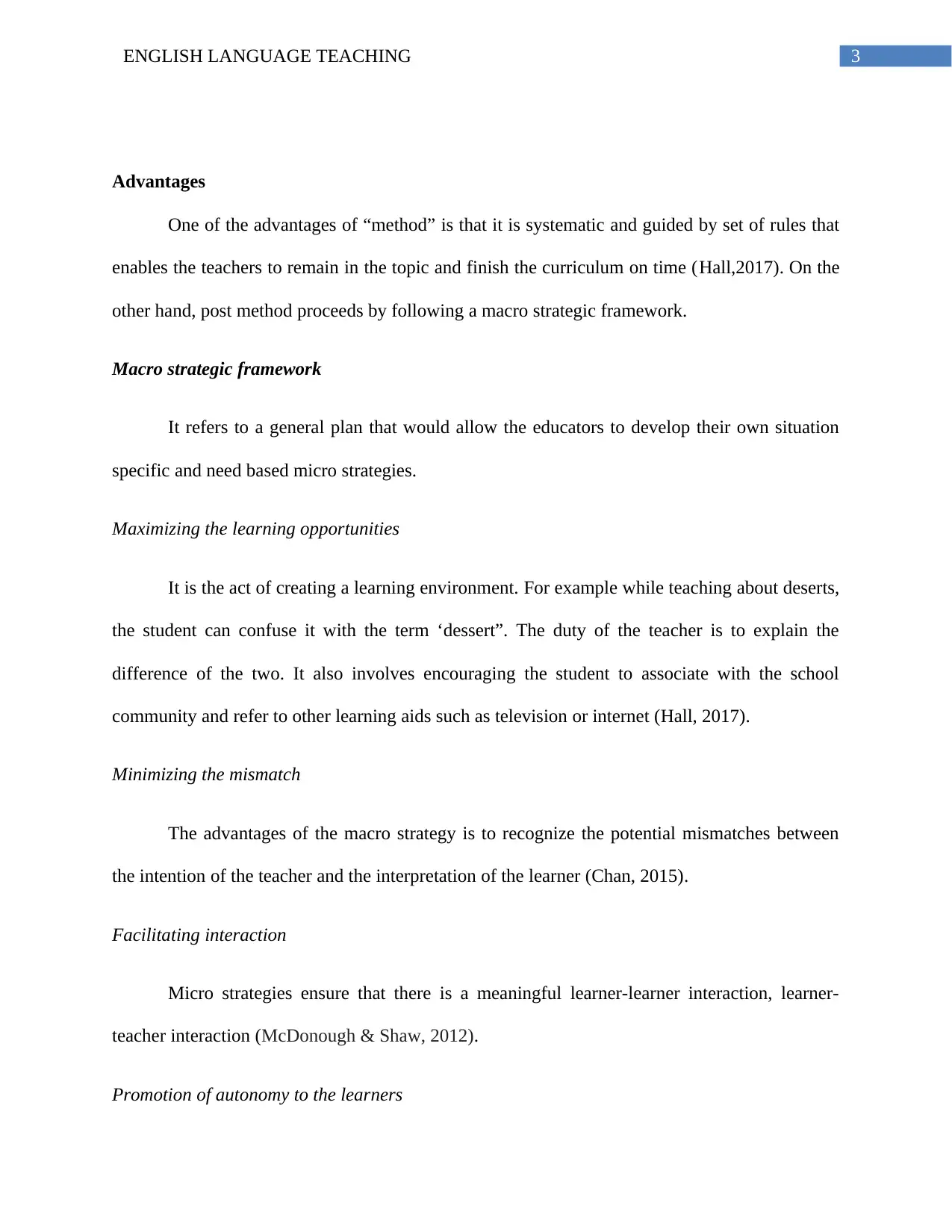
3ENGLISH LANGUAGE TEACHING
Advantages
One of the advantages of “method” is that it is systematic and guided by set of rules that
enables the teachers to remain in the topic and finish the curriculum on time (Hall,2017). On the
other hand, post method proceeds by following a macro strategic framework.
Macro strategic framework
It refers to a general plan that would allow the educators to develop their own situation
specific and need based micro strategies.
Maximizing the learning opportunities
It is the act of creating a learning environment. For example while teaching about deserts,
the student can confuse it with the term ‘dessert”. The duty of the teacher is to explain the
difference of the two. It also involves encouraging the student to associate with the school
community and refer to other learning aids such as television or internet (Hall, 2017).
Minimizing the mismatch
The advantages of the macro strategy is to recognize the potential mismatches between
the intention of the teacher and the interpretation of the learner (Chan, 2015).
Facilitating interaction
Micro strategies ensure that there is a meaningful learner-learner interaction, learner-
teacher interaction (McDonough & Shaw, 2012).
Promotion of autonomy to the learners
Advantages
One of the advantages of “method” is that it is systematic and guided by set of rules that
enables the teachers to remain in the topic and finish the curriculum on time (Hall,2017). On the
other hand, post method proceeds by following a macro strategic framework.
Macro strategic framework
It refers to a general plan that would allow the educators to develop their own situation
specific and need based micro strategies.
Maximizing the learning opportunities
It is the act of creating a learning environment. For example while teaching about deserts,
the student can confuse it with the term ‘dessert”. The duty of the teacher is to explain the
difference of the two. It also involves encouraging the student to associate with the school
community and refer to other learning aids such as television or internet (Hall, 2017).
Minimizing the mismatch
The advantages of the macro strategy is to recognize the potential mismatches between
the intention of the teacher and the interpretation of the learner (Chan, 2015).
Facilitating interaction
Micro strategies ensure that there is a meaningful learner-learner interaction, learner-
teacher interaction (McDonough & Shaw, 2012).
Promotion of autonomy to the learners
Paraphrase This Document
Need a fresh take? Get an instant paraphrase of this document with our AI Paraphraser
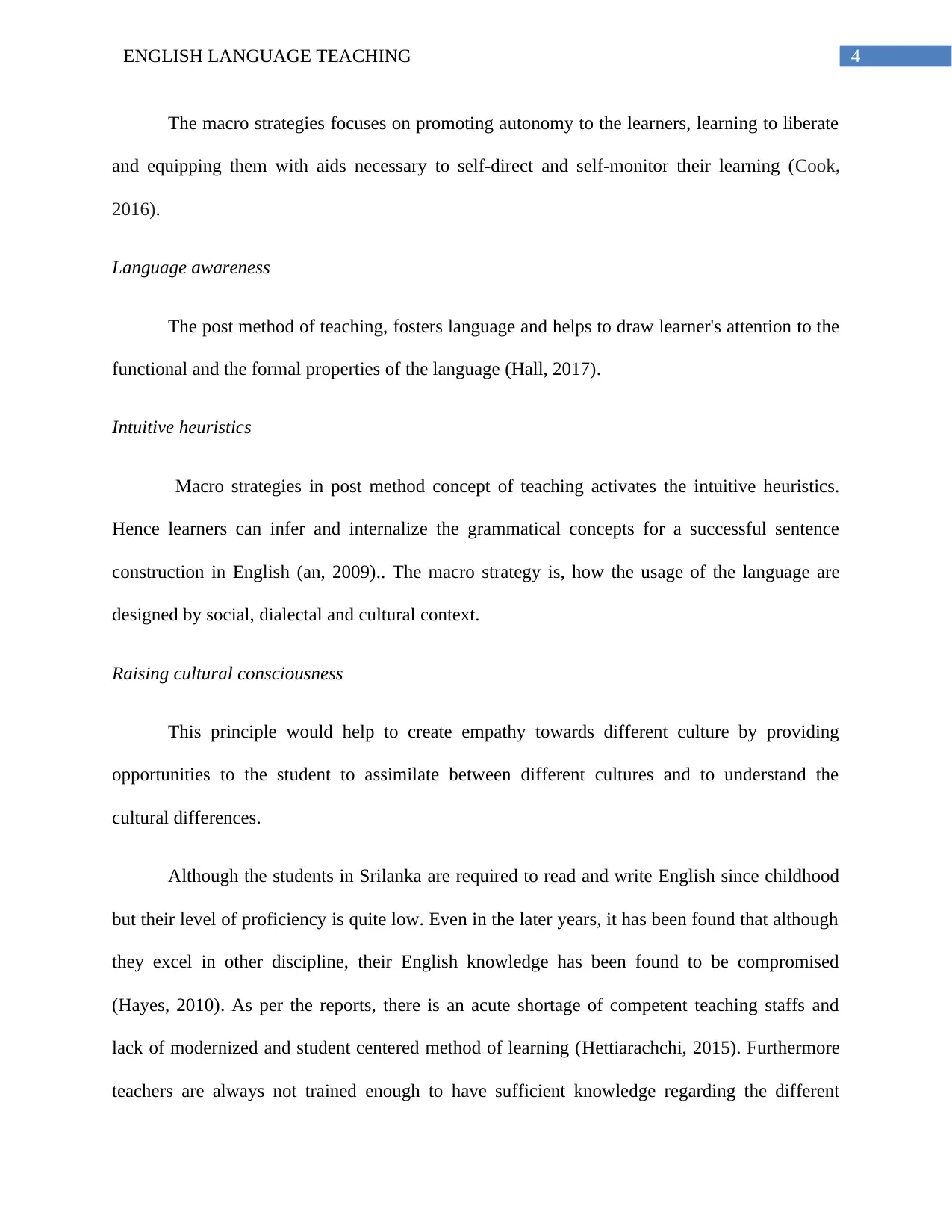
4ENGLISH LANGUAGE TEACHING
The macro strategies focuses on promoting autonomy to the learners, learning to liberate
and equipping them with aids necessary to self-direct and self-monitor their learning (Cook,
2016).
Language awareness
The post method of teaching, fosters language and helps to draw learner's attention to the
functional and the formal properties of the language (Hall, 2017).
Intuitive heuristics
Macro strategies in post method concept of teaching activates the intuitive heuristics.
Hence learners can infer and internalize the grammatical concepts for a successful sentence
construction in English (an, 2009).. The macro strategy is, how the usage of the language are
designed by social, dialectal and cultural context.
Raising cultural consciousness
This principle would help to create empathy towards different culture by providing
opportunities to the student to assimilate between different cultures and to understand the
cultural differences.
Although the students in Srilanka are required to read and write English since childhood
but their level of proficiency is quite low. Even in the later years, it has been found that although
they excel in other discipline, their English knowledge has been found to be compromised
(Hayes, 2010). As per the reports, there is an acute shortage of competent teaching staffs and
lack of modernized and student centered method of learning (Hettiarachchi, 2015). Furthermore
teachers are always not trained enough to have sufficient knowledge regarding the different
The macro strategies focuses on promoting autonomy to the learners, learning to liberate
and equipping them with aids necessary to self-direct and self-monitor their learning (Cook,
2016).
Language awareness
The post method of teaching, fosters language and helps to draw learner's attention to the
functional and the formal properties of the language (Hall, 2017).
Intuitive heuristics
Macro strategies in post method concept of teaching activates the intuitive heuristics.
Hence learners can infer and internalize the grammatical concepts for a successful sentence
construction in English (an, 2009).. The macro strategy is, how the usage of the language are
designed by social, dialectal and cultural context.
Raising cultural consciousness
This principle would help to create empathy towards different culture by providing
opportunities to the student to assimilate between different cultures and to understand the
cultural differences.
Although the students in Srilanka are required to read and write English since childhood
but their level of proficiency is quite low. Even in the later years, it has been found that although
they excel in other discipline, their English knowledge has been found to be compromised
(Hayes, 2010). As per the reports, there is an acute shortage of competent teaching staffs and
lack of modernized and student centered method of learning (Hettiarachchi, 2015). Furthermore
teachers are always not trained enough to have sufficient knowledge regarding the different
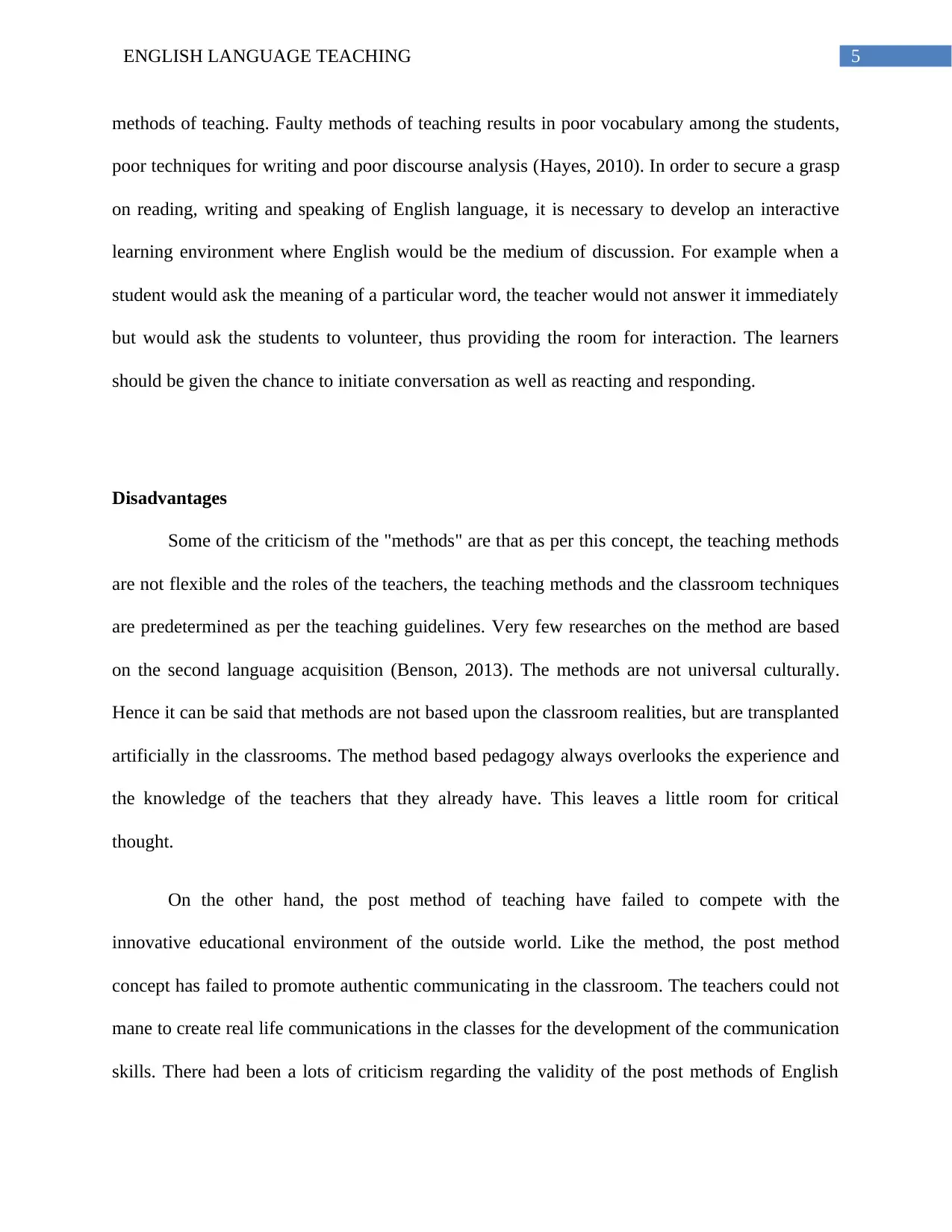
5ENGLISH LANGUAGE TEACHING
methods of teaching. Faulty methods of teaching results in poor vocabulary among the students,
poor techniques for writing and poor discourse analysis (Hayes, 2010). In order to secure a grasp
on reading, writing and speaking of English language, it is necessary to develop an interactive
learning environment where English would be the medium of discussion. For example when a
student would ask the meaning of a particular word, the teacher would not answer it immediately
but would ask the students to volunteer, thus providing the room for interaction. The learners
should be given the chance to initiate conversation as well as reacting and responding.
Disadvantages
Some of the criticism of the "methods" are that as per this concept, the teaching methods
are not flexible and the roles of the teachers, the teaching methods and the classroom techniques
are predetermined as per the teaching guidelines. Very few researches on the method are based
on the second language acquisition (Benson, 2013). The methods are not universal culturally.
Hence it can be said that methods are not based upon the classroom realities, but are transplanted
artificially in the classrooms. The method based pedagogy always overlooks the experience and
the knowledge of the teachers that they already have. This leaves a little room for critical
thought.
On the other hand, the post method of teaching have failed to compete with the
innovative educational environment of the outside world. Like the method, the post method
concept has failed to promote authentic communicating in the classroom. The teachers could not
mane to create real life communications in the classes for the development of the communication
skills. There had been a lots of criticism regarding the validity of the post methods of English
methods of teaching. Faulty methods of teaching results in poor vocabulary among the students,
poor techniques for writing and poor discourse analysis (Hayes, 2010). In order to secure a grasp
on reading, writing and speaking of English language, it is necessary to develop an interactive
learning environment where English would be the medium of discussion. For example when a
student would ask the meaning of a particular word, the teacher would not answer it immediately
but would ask the students to volunteer, thus providing the room for interaction. The learners
should be given the chance to initiate conversation as well as reacting and responding.
Disadvantages
Some of the criticism of the "methods" are that as per this concept, the teaching methods
are not flexible and the roles of the teachers, the teaching methods and the classroom techniques
are predetermined as per the teaching guidelines. Very few researches on the method are based
on the second language acquisition (Benson, 2013). The methods are not universal culturally.
Hence it can be said that methods are not based upon the classroom realities, but are transplanted
artificially in the classrooms. The method based pedagogy always overlooks the experience and
the knowledge of the teachers that they already have. This leaves a little room for critical
thought.
On the other hand, the post method of teaching have failed to compete with the
innovative educational environment of the outside world. Like the method, the post method
concept has failed to promote authentic communicating in the classroom. The teachers could not
mane to create real life communications in the classes for the development of the communication
skills. There had been a lots of criticism regarding the validity of the post methods of English
⊘ This is a preview!⊘
Do you want full access?
Subscribe today to unlock all pages.

Trusted by 1+ million students worldwide
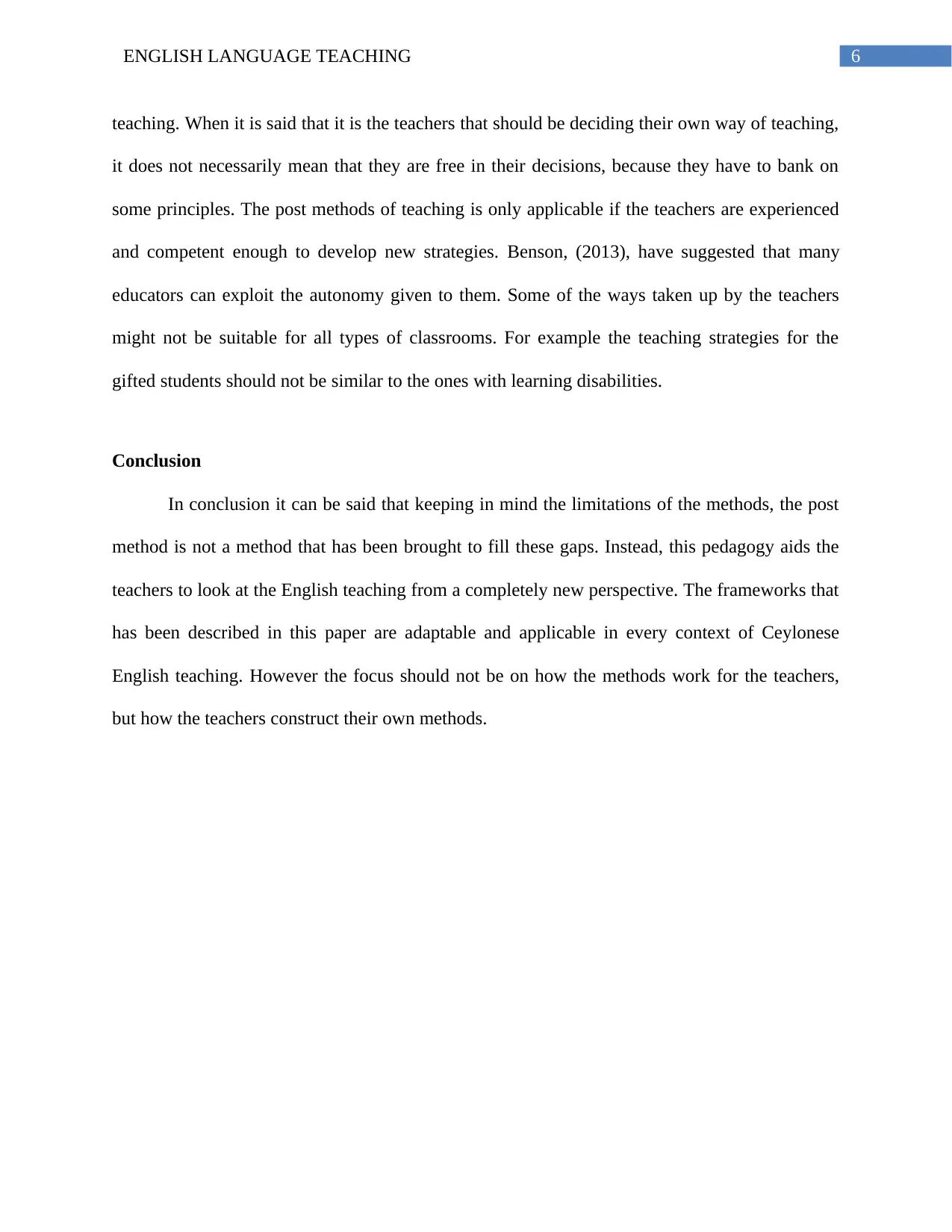
6ENGLISH LANGUAGE TEACHING
teaching. When it is said that it is the teachers that should be deciding their own way of teaching,
it does not necessarily mean that they are free in their decisions, because they have to bank on
some principles. The post methods of teaching is only applicable if the teachers are experienced
and competent enough to develop new strategies. Benson, (2013), have suggested that many
educators can exploit the autonomy given to them. Some of the ways taken up by the teachers
might not be suitable for all types of classrooms. For example the teaching strategies for the
gifted students should not be similar to the ones with learning disabilities.
Conclusion
In conclusion it can be said that keeping in mind the limitations of the methods, the post
method is not a method that has been brought to fill these gaps. Instead, this pedagogy aids the
teachers to look at the English teaching from a completely new perspective. The frameworks that
has been described in this paper are adaptable and applicable in every context of Ceylonese
English teaching. However the focus should not be on how the methods work for the teachers,
but how the teachers construct their own methods.
teaching. When it is said that it is the teachers that should be deciding their own way of teaching,
it does not necessarily mean that they are free in their decisions, because they have to bank on
some principles. The post methods of teaching is only applicable if the teachers are experienced
and competent enough to develop new strategies. Benson, (2013), have suggested that many
educators can exploit the autonomy given to them. Some of the ways taken up by the teachers
might not be suitable for all types of classrooms. For example the teaching strategies for the
gifted students should not be similar to the ones with learning disabilities.
Conclusion
In conclusion it can be said that keeping in mind the limitations of the methods, the post
method is not a method that has been brought to fill these gaps. Instead, this pedagogy aids the
teachers to look at the English teaching from a completely new perspective. The frameworks that
has been described in this paper are adaptable and applicable in every context of Ceylonese
English teaching. However the focus should not be on how the methods work for the teachers,
but how the teachers construct their own methods.
Paraphrase This Document
Need a fresh take? Get an instant paraphrase of this document with our AI Paraphraser
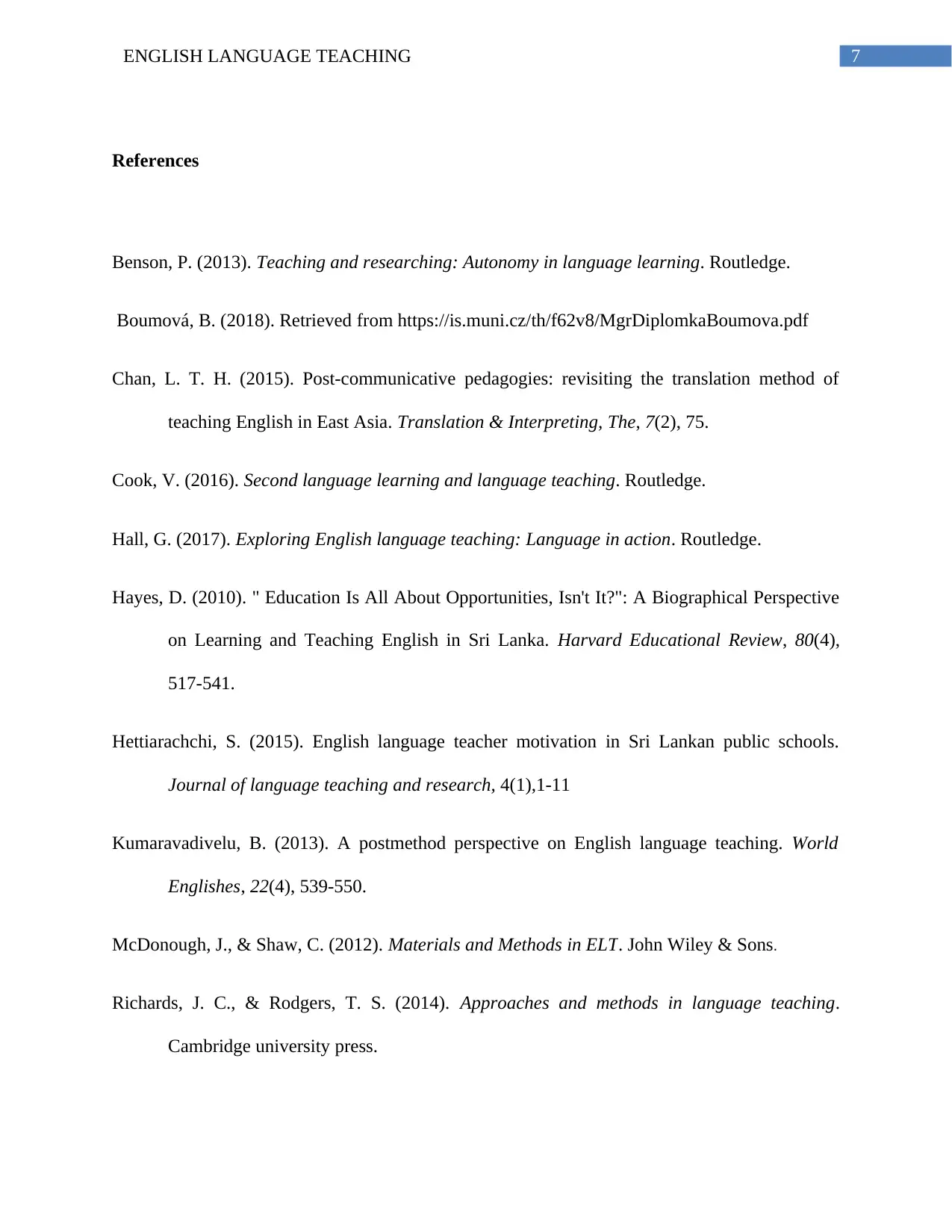
7ENGLISH LANGUAGE TEACHING
References
Benson, P. (2013). Teaching and researching: Autonomy in language learning. Routledge.
Boumová, B. (2018). Retrieved from https://is.muni.cz/th/f62v8/MgrDiplomkaBoumova.pdf
Chan, L. T. H. (2015). Post-communicative pedagogies: revisiting the translation method of
teaching English in East Asia. Translation & Interpreting, The, 7(2), 75.
Cook, V. (2016). Second language learning and language teaching. Routledge.
Hall, G. (2017). Exploring English language teaching: Language in action. Routledge.
Hayes, D. (2010). " Education Is All About Opportunities, Isn't It?": A Biographical Perspective
on Learning and Teaching English in Sri Lanka. Harvard Educational Review, 80(4),
517-541.
Hettiarachchi, S. (2015). English language teacher motivation in Sri Lankan public schools.
Journal of language teaching and research, 4(1),1-11
Kumaravadivelu, B. (2013). A postmethod perspective on English language teaching. World
Englishes, 22(4), 539-550.
McDonough, J., & Shaw, C. (2012). Materials and Methods in ELT. John Wiley & Sons.
Richards, J. C., & Rodgers, T. S. (2014). Approaches and methods in language teaching.
Cambridge university press.
References
Benson, P. (2013). Teaching and researching: Autonomy in language learning. Routledge.
Boumová, B. (2018). Retrieved from https://is.muni.cz/th/f62v8/MgrDiplomkaBoumova.pdf
Chan, L. T. H. (2015). Post-communicative pedagogies: revisiting the translation method of
teaching English in East Asia. Translation & Interpreting, The, 7(2), 75.
Cook, V. (2016). Second language learning and language teaching. Routledge.
Hall, G. (2017). Exploring English language teaching: Language in action. Routledge.
Hayes, D. (2010). " Education Is All About Opportunities, Isn't It?": A Biographical Perspective
on Learning and Teaching English in Sri Lanka. Harvard Educational Review, 80(4),
517-541.
Hettiarachchi, S. (2015). English language teacher motivation in Sri Lankan public schools.
Journal of language teaching and research, 4(1),1-11
Kumaravadivelu, B. (2013). A postmethod perspective on English language teaching. World
Englishes, 22(4), 539-550.
McDonough, J., & Shaw, C. (2012). Materials and Methods in ELT. John Wiley & Sons.
Richards, J. C., & Rodgers, T. S. (2014). Approaches and methods in language teaching.
Cambridge university press.
1 out of 8
Related Documents
Your All-in-One AI-Powered Toolkit for Academic Success.
+13062052269
info@desklib.com
Available 24*7 on WhatsApp / Email
![[object Object]](/_next/static/media/star-bottom.7253800d.svg)
Unlock your academic potential
Copyright © 2020–2025 A2Z Services. All Rights Reserved. Developed and managed by ZUCOL.





